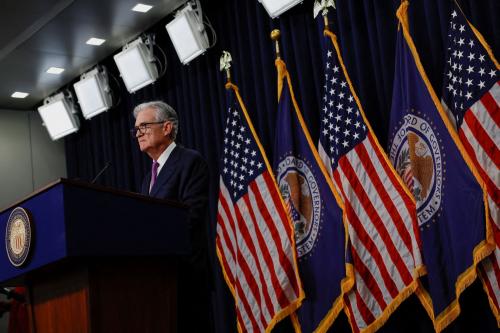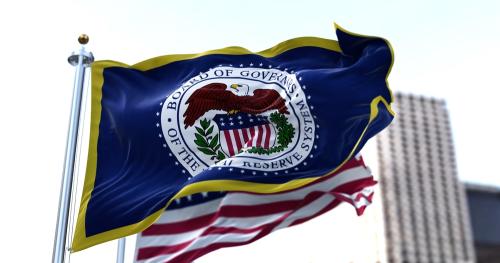For the past year, the Federal Reserve’s policy committee, the Federal Open Market Committee (FOMC), has described the timing of its much-anticipated move to raise interest rates as “data dependent,” or some variant of that phrase.
But what exactly does that mean? And does the phrase accurately convey how the FOMC is thinking about the economy and interest rates?
FOMC minutes from June and July 2014 suggest that the introduction of the phrase “data dependent” had the express goal of keeping markets from growing complacent. In June, some FOMC members expressed concern that “low implied volatility in equity, currency, and fixed-income markets” indicated that “market participants were not factoring in sufficient uncertainty about the path of the economy and monetary policy.” In short, Fed officials thought their forecasts about the future path of rates were being taken too seriously—more like commitments than predictions. They agreed that “the Committee should…emphasize in its communications the dependence of its policy decisions on the evolution of the economic outlook.”
At the meeting in July, Charles Plosser, then-president of the Federal Reserve Bank of Philadelphia, decided to push for an emphasis on “data dependency.” He objected to the FOMC’s statement that said interest rates would remain near zero “for a considerable time,” and argued that “the reference to calendar time should be replaced with language that indicates how monetary policy will respond to incoming data.” The minutes reveal that unnamed “participants” (of whom Mr. Plosser was almost certainly one) suggested “that the guidance should more clearly communicate how policy-setting would respond to the evolution of economic data.”
The emphasis on data dependency won out. Earlier this year, Chair Yellen stated that: “Of course, the timing of the first increase in the federal funds rate and its subsequent path will be determined by the Committee in light of incoming data.” The phrase figures more prominently than talk of economic outlook.
Some may believe the distinction is not significant—outlook, data, it’s all the same. Others, including our Brookings colleague Donald Kohn, a former Fed vice chairman, think the choice of words matters. “Outlook” seems more inertial, and future-based. The “outlook” rarely changes dramatically based on a single economic report, whereas talk by the FOMC members of the decision-making process’s being “data dependent,” combined with hints that the Fed is particularly interested in a given economic indicator’s upcoming release, can imply that the newest indicator has outsized influence. Just look at headlines describing the August jobs report, issued Sept. 4, as pivotal in the interest-rate decision the Fed will make on Sept. 16-17.
“I like to think of the Fed’s decisions as being outlook-dependent,” says Mr. Kohn. “The Fed talks about data dependency, and data are important, but you have to be careful not to overreact to individual pieces of data, and by processing the data through an outlook, a forecast, I think that’s one way of trying to extract the signal from the noise of the data, and not overreact, and I think about how it affects where things will be one to three years from now.”
Julia Coronado, chief economist at Graham Capital and former Fed economist, shares Mr. Kohn’s reservations about the “data dependent” framing. She agrees with the Fed’s goal of combating market complacency, but that “the pendulum has swung too far to the other side where they’re inadvertently stoking market volatility on high-frequency data releases.”
“I don’t think that really represents how they’re making decisions,” she continued, “but it’s a combination of the way they’re describing data dependency publicly, reacting to different data, going on CNBC after the employment report and saying: ‘Well, that’s a pretty good number.’ That’s not helpful. And the ‘every meeting live,’ ‘we could go at any time,’ ‘it’s very data-dependent,’ tends to focus markets on: ‘Well, if the payroll number’s good tomorrow, we could go.’”
Ms. Coronado believes that’s not an accurate representation of how the Fed makes decisions: “The deliberation at the table will be looking at the fullness of the accumulated progress, the outlook, the risks to the outlook. I think the tone of the framing of the reaction function hasn’t been optimal…Somewhere in between there’s a medium where you can provide some guidance,” but also keep the dollar from “spiking ahead of every Fed meeting.”
Jon Faust, a Johns Hopkins University economist and former adviser to Fed Chair Janet Yellen, also argues the phrase “sometimes…makes it seem as if the FOMC is saying: ‘We’re on the edge of our seat all the time, about ready to tip one way or another.’”
“They need to communicate more effectively…that it’s outlook-dependent, and the outlook…for a year to three in the future changes rather gradually. So it’s affected by Friday’s employment report, but not by much…Sometimes the message can come across as if they’re skittish or something.”
The Fed is trying to convey a message more subtle than the markets, the press and the politicians can absorb: If the economy evolves as we expect, we’re going to raise interest rates soon. But that prediction depends on how the economy evolves; if the economy surprises us and our outlook for unemployment and inflation changes, then don’t complain if we don’t raise rates as soon as you expected.
The Fed has a great deal of experiencing distinguishing signal from noise in the volatile economic indicators it uses to decide interest rates. But in an era of ever-more transparency, its well-intentioned attempt to be clear may be broadcasting more noise than necessary.



Commentary
What the Fed really means when it says interest rate raises are data dependent
September 10, 2015